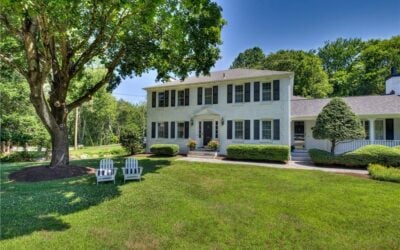Above: The long stone pergola at Stoneleigh is covered with native vines. Photo by George Christie
By George Christie
Why go to Villanova, Pennsylvania, to visit an estate? Don’t we have plenty of estates in Rhode Island that are open to the public? Well, sure, but “Stoneleigh, a natural garden,” has a difference, and one that is important for those of us who are trying to reintroduce native plants into as many Rhode Island gardens as we can. At Stoneleigh they are reinvigorating the formal gardens by using only native plants.
Donated to an organization known as Natural Lands in 2016, Stoneleigh is something of an anomaly among the 40+ nature preserves the nonprofit oversees. So, it shouldn’t be surprising that their garden is something of an anomaly in formal garden design. For many designers, the hybrids and cultivars of plants that originated in Europe and Asia are the blandly familiar plants of formal gardens. But there’s no reason why North American plants can’t be just as well integrated into such landscapes, if both plants and people make a few adjustments.
Which is why, when I heard about Stoneleigh, I knew I wanted to visit it. So, several weeks ago, my wife and I headed to New Jersey. Joined by my two sisters and their husbands, we toured Stoneleigh on a beautiful Sunday in early June. As I said, Stoneleigh is a different sort of estate, the main house is open for special occasions, but it is the gardens that people come for. Tucked in a neighborhood just north of the Villanova campus, stately hemlocks shield the inner gardens from the traffic on the surrounding roads.
The parking lot is tucked in a corner of the estate and leads to a welcome kiosk where volunteers are eager to orient you to the grounds. From there one enters the great lawn, a hallmark of parklike English estates. Here native redbud cultivars are being planted. Closer to the house large evergreen southern magnolias and twelve-foot flowering elderberry provided the backdrop for flower beds of bergamot, columbine, foxglove beardtongue, and many more. I was particularly pleased to see a beach plum used in foundation planting. I’ve long thought of this small shrub as a very underused decorative plant. It blooms early and its white blooms are pollinator magnets. Easily shaped, its green foliage holds up well throughout the summer and, in most years, you get grape sized plums!
Somewhat more surprising was the prickly pear cactus located right next to the doors from the house to the veranda. I wasn’t sure such thorny plants were a good idea so close to high-traffic areas, but then remembered the strange value we place on barberry, a plant notable for its horrid thorns, irrelevant flowers and unkempt looks in every garden where people have to prune it. Give me prickly pear any day of the year!
Don’t get me wrong, Stoneleigh is very much a work in progress. 2016 There is little reason to alter the general design of the gardens and the garden staff has no desire to replace plants willy-nilly. But the direction is clear. Some plants play familiar roles, eastern arborvitae serves the same purposes at Stoneleigh as elsewhere, and mountain laurel peaks from the dappled-shade borders of garden nooks. But Redbud cultivars in yellow-green and burgundy take the place of Japanese maples, and a young sweetgum (Liquidambar styraciflua) graces a spot where one might find a Kousa dogwood in other settings.
Still, what impressed me most was just how familiar the gardens felt when one stood back and viewed them as a whole, rather than as an array of plants. True, the arrangement was a bit less formal, and the pruning was not as defined, but the dogbane hedge was clearly a hedge and the restored stone pergola, festooned with Virginia creeper, native honeysuckle and trumpet vine was every bit as comfortably beautiful as it would have been covered with clematis and climbing rose.
The message of Stoneleigh is clear, beauty can emerge from thoughtful design with plants from any continent. Indeed, Jens Jensen, a hugely influential landscape architect in the mid-west prairie style of the early 20th century, was adamant that native plants, due to their pre-adaptation to the local land, were inherently superior to non-natives regardless of the type of garden one wished to create. He even warned us of the dangers of relying too much on non-native plants.
“The great destruction brought to our country through foreign importations must prove alarming to the future. Many of these importations will in time become the [house] sparrows of the plant world and destructive to the beauty which is ours.”
We are living the future of which he warned. Still, we cannot go back to the native woodlands and meadows of New England 500 years ago. But neither do we have to continue to plant the cloned hybrids of European and Asian flora that overwhelm the benches of our garden centers and fill our gardens with drab predictability. The foresighted designers of the new garden at Stoneleigh are showing us a new path, a better path, a path designed to be shared with our own, native wildlife. If the choice is the formality of European nobles or the flutter of New England butterflies, I choose the latter, and regret not the unpruned branch or partly eaten leaf.
Stoneleigh is free and open to the public from Tuesday to Sunday each week between 10 am and 5 pm. Many of the native plants they use are carefully selected from one of their 40+ nature preserves, ensuring they are as locally sourced as possible. Read more at: https://stoneleighgarden.org/garden/home/
Jens Jensen’s “Siftings” (1939) (reprinted 1990, Johns Hopkins Paperbacks, Baltimore, MD) is an inspirational guide, written well ahead of its time. It is not, sadly, available through the Ocean State Library system, but can be ordered online.
George Christie studied entomology and landscape architecture and has worked in mosquito control, environmental education and garden design and plant sales. He currently works for the Rhode Island Natural History Survey managing their rare species database.

A perfectly “formal” garden walkway includes native arborvitae, redbud and sweet gum. Photo by George Christie

My sister Anne walks past a lovely southern magnolia. Photo by George Christie

Beach plum and prickly pear are used as foundation plantings. Photo by George Christiez






 Subscribe
Subscribe